
| Palaeos |  |
Glossary |
| Plants | Glossary A-C |
Unit References |
Unit Dendrogram |
Page Next | ||
Pieces |
A really extraordinary botanical glossary can be found at A glossary of botanical terms. Bluntly, it is far better than our own glossary, but lacks images and hyperlinks. I can't seem to get the French version to work, but it may be even better.
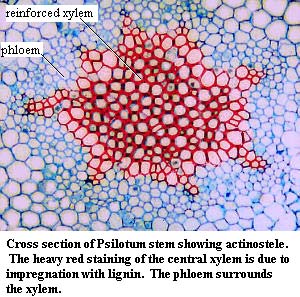 Actinostele: a type of
protostele
that looks like a star in cross section. The walls of the stele are
heavily reinforced with lignin and are relatively thick.
Xylem
occupies the center but the phloem occupies the indentations in the xylem. This
generates the star-like pattern. Image from the Botany
210 site of Prof. David Webb at the University of Hawaii at Manoa.
Actinostele: a type of
protostele
that looks like a star in cross section. The walls of the stele are
heavily reinforced with lignin and are relatively thick.
Xylem
occupies the center but the phloem occupies the indentations in the xylem. This
generates the star-like pattern. Image from the Botany
210 site of Prof. David Webb at the University of Hawaii at Manoa.
Active transport: transport across a cell membrane which requires energy generated by the hydrolysis of some energy carrier (usually ATP). The selective active transport of ions (usually sodium) out of the cell is often used as a secondary energy storage mechanism. See ion gradient system.
Adaxial: "on the upper surface; situated or directed toward an axis." Virtual Paleobotany Lab Glossary (Univ. Calif. Berkeley)
Alternation of generations: a life cycle in which there are two stages: (a) a diploid, sporophyte stage which produces haploid spores by meiosis, and (b) a haploid, gametophyte stage which produces (by mitosis) haploid gametes of two types, usually called male and female but technically microgametes and megagametes. The female gamete is fertilized to become a diploid zygote, which matures to become a diploid sporophyte, completing the cycle. Either the gametophyte or the sporophyte stage may be very small and remain attached to the other stage. According to Taylor et al. (2005):
Two principal theories have been proposed to explain the evolution of the dimorphic alternation of generations that characterizes vascular plants and bryophytes. The antithetic theory suggests that the sporophyte generation evolved from a haploid green algal thallus in which repeated mitotic cell divisions of a zygote resulting in an embryo retained on the thallus gave rise to the diploid phase (sporophyte). Evidence supporting this theory can be found in the life cycle of modern bryophytes in which the sporophyte is physiologically dependent on the gametophyte. Although generally not addressed, the antithetic theory necessitates that both types of gametangia were probably borne on the same thallus. The homologous theory assumes a green algal ancestor but with two nearly identical (isomorphic) phases, one producing gametes, the other producing spores. Various stages in the evolution of the sporophyte have been postulated, leading to the sporophyte becoming the dominant phase both morphologically and physiologically. The increasing size and complexity of the sporophyte phase results in more sporangia and spores being produced, and thus with potentially greater genetic variation represented among these spores, there is a corresponding increase in the probability of successful colonization of additional habitats. The gametophytic phase, although a less conspicuous part of the life cycle and not essential in local areas of clonal growth of the sporophyte, is equally essential for the long-term success of the species. Although hermaphroditic (bisexual) gametophytes may turn out ultimately to be the primitive type, all of the gametophytes thus far described from the Rhynie chert appear to be unisexual. [citations omitted].
Amphithecium: The outer, "ectodermal" cell layer of the sporophyte in basal plants.
Anisotomous: branching pattern. Branching system in which the daughter axes are of unequal diameter. Kenrick & Crane (1997). Compare isotomous.
Anispory: Intersporangial heterospory. That is, segregation of male and female spores into different sporangia. Taylor et al. (2005). Or, to be more accurate, the segregation into different sporangia of spores which will develop into gametophytes producing male and female gametes. Taylor et al.'s point is that anispory is often thought to be the basal condition, yet it doesn't seem to apply to Rhynie Chert plants. All of the spores in the Rhynie sporophytes look exactly alike, yet the Rhynie gametophytes are all unisexual.
Annual: a plant with a lifespan of one year.
 Annulus: specialized structure of some fern sporangia that is involved in the opening of the sporangium. In some mosses, on drying out the cells of the annulus contract and the sporangium ruptures, releasing the spores. In others, the annulus bears the peristome teeth, which perform a similar function. Image from the Biology 3560 site of the University of Lethbridge (Alberta).
Annulus: specialized structure of some fern sporangia that is involved in the opening of the sporangium. In some mosses, on drying out the cells of the annulus contract and the sporangium ruptures, releasing the spores. In others, the annulus bears the peristome teeth, which perform a similar function. Image from the Biology 3560 site of the University of Lethbridge (Alberta).
Anther: in a flower, the terminal part of the stamen which holds the pollen; an antheridium.
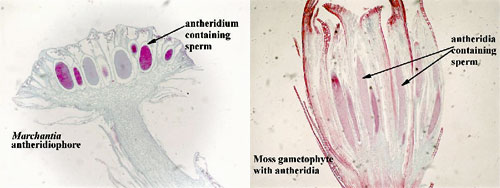 Antheridiophore: essentially the same as antheridium. If you care desperately about the distinction, see gametangiophore for a fuller explanation. Image from the Biology 102 Lab site of Brookdale Community College (New Jersey).
Antheridiophore: essentially the same as antheridium. If you care desperately about the distinction, see gametangiophore for a fuller explanation. Image from the Biology 102 Lab site of Brookdale Community College (New Jersey).
Antheridium: reproductive structure that produces male gametophytes (pollen).
Apical: from or towards the apex, or tip, of a plant axis (stem, branch, root, etc.).
Apical meristem: see meristem.
Apomorphy: a character state which is unique to a single, terminal taxon. Example: among primates, complex grammar is an apomorphy of human beings. It is quite diagnostic of humans, but useless in determining phylogenetic relationships because it is not a shared, derived characteristic, or synapomorphy, of any larger group.
Arborescent: of tree-like growth-habit, a tree. A woody plant.
Archegoniophore: essentially the same as archegonium. If you care desperately about the distinction, see gametangiophore for a fuller explanation.
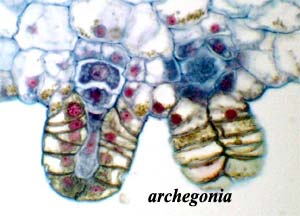 Archegonium: reproductive structure that produces female gametes (egg). Image from the Department of Botany site of the University of Wisconsin at Madison.
Archegonium: reproductive structure that produces female gametes (egg). Image from the Department of Botany site of the University of Wisconsin at Madison.
Arthrodontous: of moss sporophytes, having peristome teeth which are formed by walls growing between the rows of cells making up the mouth of the spore capsule. See Tree of Life: Bryopsida.
Autotroph: an organism which obtains energy from inorganic sources, sunlight or the oxidation of inorganic chemicals.
Autotrophic nutrition: synthesis of organic food molecules from inorganic compounds such as carbon dioxide.
Axial: with reference to a growth habit, growing upward from the substrate (e.g., trees); as opposed to thalloid, recumbent, spreading along the substrate (e.g., mosses and liverworts).
Axis: a stem, branch, root or other elongate structure conceived of as the main longitudinal structure of the plant or portion of a plant being considered.
Biennial: a plant with a lifespan of two years. Often only flowers and goes to seed (yes, that's the source of this phrase) during the second year.
Bifacial Cambium: cambium which produces tissue both towards the center (medially, periclinally, internally) and towards the surface (axially, anticlinally, externally) of a stem. Bifacial cambium builds xylem and phloem on its internal face and more cambium on the external face. Compare unifacial cambium.
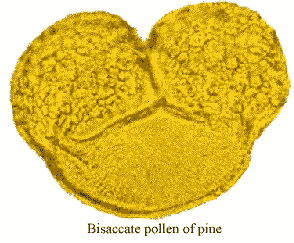 Bisaccate: a
pollen grain with two sacci.
The two "sacs" or bladders are used to promote wind dispersal.
Pollen of this type is known from as early as the Devonian. Image from the Earth
History Research Center.
Bisaccate: a
pollen grain with two sacci.
The two "sacs" or bladders are used to promote wind dispersal.
Pollen of this type is known from as early as the Devonian. Image from the Earth
History Research Center.
Budding: reproduction by binary fission, a characteristic form of propagation in yeasts. "The onset of the cellular events is accompanied by the nuclear events of mitosis. ... The initial events of budding can be seen as the development of a ring of chitin around the point where the bud is about to appear. This reinforces and stabilizes the cell wall. Enzymatic activity and turgor pressure the act to weaken and extrude the cell wall. New cell wall material is incorporated during this phase. Cell contents are forced into the progeny cell, and as the final phase of mitosis ends a cell plate, the point at which a new cell wall will grow inwards from, forms." Reproduction in the fungi (former http:// www-micro. msb. le. ac. uk/ 224/ mycology/ 2. html).
Bulb: an underground stem bearing modified (scalelike) leaves and fibrous basal roots; generally food storage organs.
Bulbil: a bulb produced above the ground, often on the flowering stem or on a leaf axil.
Calyptra: in mosses, a derivative of the distal archegonium forms a hard, protective layer around the developing sporophyte called the epigonium. Later the epigonium breaks up, but the sporophyte retains a conical "dunce cap" over its distal end, and sometimes a ring around the base. The cap is the calyptra. The piece retained around the base is the vaginula.
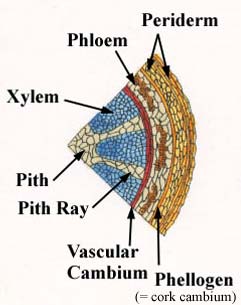 Cambium: a layer of actively dividing cells (lateral meristem), found within stems and roots, that gives rise to secondary growth in perennial plants, causing an increase in girth. There are two main types of cambium: vascular cambium, which gives rise to secondary xylem and phloem tissues, and cork cambium (or phellogen), which gives rise to secondary cortex and cork tissues, as in bark. Image from the Population Biology site of San Diego State University. The vascular cambium surrounds the roots, trunk, branches, and shoots, extending throughout a tree. Each year, the vascular cambium produces a new layer of phloem toward the outside of the tree and a new layer of xylem, or wood, toward the inside.
Cambium: a layer of actively dividing cells (lateral meristem), found within stems and roots, that gives rise to secondary growth in perennial plants, causing an increase in girth. There are two main types of cambium: vascular cambium, which gives rise to secondary xylem and phloem tissues, and cork cambium (or phellogen), which gives rise to secondary cortex and cork tissues, as in bark. Image from the Population Biology site of San Diego State University. The vascular cambium surrounds the roots, trunk, branches, and shoots, extending throughout a tree. Each year, the vascular cambium produces a new layer of phloem toward the outside of the tree and a new layer of xylem, or wood, toward the inside.
Carpel: the female reproductive organ of a flower, consisting of stigma, style and ovary.
Cauline: of, related to, borne on, or growing from a plant stem.
Cauloneme: a lateral process from the protoneme (initial, threadlike process) which develops into the gametophore in mosses.
Cellulose: polysaccharide that consists of a long unbranched chain of glucose units; cellulose is the main constituent of the cell walls of most land plants.
Centrarch: used to describe a form of xylem development in which maturation occurs from the center of the stem to the periphery. Alternatively, a pattern of xylem maturation in which the protoxylem is central and is surrounded by metaxylem. Compare endarch, exarch, mesarch.
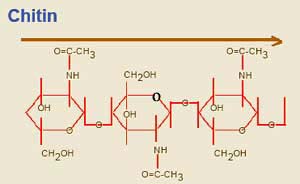 Chitin: a polymer of repeating sugar molecules (a slightly modified glucose, poly-N-acetyl-D-glucosamine). See image. Chitin is the material which makes up the exoskeleton of insects and, in more or less modified form, in almost all arthropods. In arthropods, chitin occurs in a cross-linked form, α-chitin. Significantly, it is also found in the radular "teeth" of mollusks, the setae (bristles) and jaws of annelid worms, and the cell walls of Fungi. So, this is exceedingly ancient stuff, possibly predating the split between bacteria and metazoans. [What may be of sociological interest is that the 1,5 aldose linkage was missing from the middle glucose in this diagram and no one spotted it for over a year ....]
Chitin: a polymer of repeating sugar molecules (a slightly modified glucose, poly-N-acetyl-D-glucosamine). See image. Chitin is the material which makes up the exoskeleton of insects and, in more or less modified form, in almost all arthropods. In arthropods, chitin occurs in a cross-linked form, α-chitin. Significantly, it is also found in the radular "teeth" of mollusks, the setae (bristles) and jaws of annelid worms, and the cell walls of Fungi. So, this is exceedingly ancient stuff, possibly predating the split between bacteria and metazoans. [What may be of sociological interest is that the 1,5 aldose linkage was missing from the middle glucose in this diagram and no one spotted it for over a year ....]
Chloroplast: the organelle in plant cells which performs photosynthesis. Chloroplasts are almost certainly descended from formerly free-living cyanobacteria.
Circinate: coiled, as in a fern crozier.
Clade: a group of organisms consisting of an organism and all of its descendants.
Climber: a soft- or non-woody-stemmed vine that clasps the stems or branches of trees and shrubs to raise its foliage and flowers above the ground; a type of growth form.
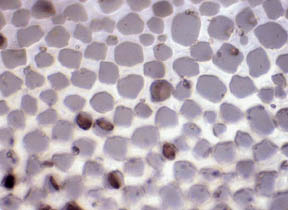 Collenchyma: Collenchyma
cells, like parenchyma cells, are living at maturity. Collenchyma cells are irregularly shaped, with walls
thicker than those of parenchymal cells due to secondary layers of cellulose. These cell walls are not lignified (woody).
Although they are fairly soft and pliable, they are arranged in strands and provide an elastic mechanical support for growing
regions of the plant. Compare parenchyma,
sclerenchyma. Image from Dr. David Lemke's Botany
1410 Lab site (Texas State Univ. -- San Marcos).
Collenchyma: Collenchyma
cells, like parenchyma cells, are living at maturity. Collenchyma cells are irregularly shaped, with walls
thicker than those of parenchymal cells due to secondary layers of cellulose. These cell walls are not lignified (woody).
Although they are fairly soft and pliable, they are arranged in strands and provide an elastic mechanical support for growing
regions of the plant. Compare parenchyma,
sclerenchyma. Image from Dr. David Lemke's Botany
1410 Lab site (Texas State Univ. -- San Marcos).
 Columella:
this is another one of those anatomical terms of almost unbelievable
generality. It refers to any small rod-like structure (and some that are
not rod-like in the slightest), such as the ear ossicle of reptiles, the basal
column of univalves in gastropods, the sterile support of the fruiting body in
fungi, and, for our purposes, either (a) a structure closely analogous to the
fungal columella in the sporophyte of basal plants; or (b) the central portion
of the root cap in higher plants. Kenrick & Crane (1997) define the columella essentially as in (a): a "[c]olumnar mass of sterile tissue that develops within the spore mass of the sporangium of horn worts, mosses, and some early fossil polysporangiophytes [= Tracheophyta]."
Columella:
this is another one of those anatomical terms of almost unbelievable
generality. It refers to any small rod-like structure (and some that are
not rod-like in the slightest), such as the ear ossicle of reptiles, the basal
column of univalves in gastropods, the sterile support of the fruiting body in
fungi, and, for our purposes, either (a) a structure closely analogous to the
fungal columella in the sporophyte of basal plants; or (b) the central portion
of the root cap in higher plants. Kenrick & Crane (1997) define the columella essentially as in (a): a "[c]olumnar mass of sterile tissue that develops within the spore mass of the sporangium of horn worts, mosses, and some early fossil polysporangiophytes [= Tracheophyta]."
Complex tissue: tissue that consists of more than one cell type, e.g. phloem.
Compound: in leaf (megaphyll) classification, a leaf with multiple separate blades.
Cork a plant tissue composed of cells whose walls are impregnated with suberin and are non-living at maturity; cork is produced by the cork cambium.
Cork cambium: a narrow cylindrical sheath of meristematic cells that produces cork cells to replace the epidermis during secondary growth (growth in width). A type of cambium, also called phellogen.
Cormus: currently used to refer to a bulb, but appears to have had one or more specialized meanings in Nineteenth Century botany which we have not been able to nail down. We mention it only in the vague hope that someone will supply us (augwhite@sbcglobal.net) with a better explanation of this term.
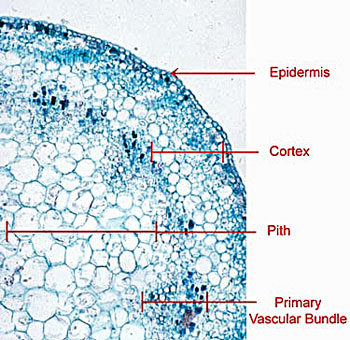 Cortex: a primary tissue composed mainly of parenchyma cells, which extends between the epidermis and the vascular tissue. Image from Nola Kinaston's Virtual Crops Grape site (Univ. Calif. Davis).
Cortex: a primary tissue composed mainly of parenchyma cells, which extends between the epidermis and the vascular tissue. Image from Nola Kinaston's Virtual Crops Grape site (Univ. Calif. Davis).
Costa: the midline vein, nerve or midrib of a bryophyte leaf (or phyllid).
Costate: having a mid-line vein or rib
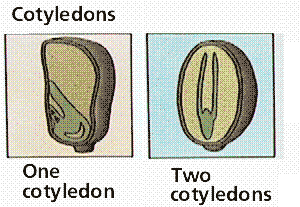 Cotyledon: the embryo leaf or leaves of seed plants that absorbs nutrients packaged in the seed, until the seedling is able to produce its first true leaves and begin photosynthesis. "The number of cotyledons present in an embryo is an important character in the classification of flowering plants (angiosperms). Monocotyledons (such as grasses, palms, and lilies) have a single cotyledon, whereas dicotyledons (the majority of plant species) have two. In seeds that also contain endosperm (nutritive tissue), the cotyledons are thin, but where they are the primary food-storing tissue, as in peas and beans, they may be quite large. After germination the cotyledons either remain below ground (hypogeal) or, more commonly, spread out above soil level (epigeal) and become the first green leaves. In gymnosperms there may be up to a dozen cotyledons within each seed. Tiscali. Image from the Online Biology Book by Dr. Mike Farabee of Estrella Mountain Community College.
Cotyledon: the embryo leaf or leaves of seed plants that absorbs nutrients packaged in the seed, until the seedling is able to produce its first true leaves and begin photosynthesis. "The number of cotyledons present in an embryo is an important character in the classification of flowering plants (angiosperms). Monocotyledons (such as grasses, palms, and lilies) have a single cotyledon, whereas dicotyledons (the majority of plant species) have two. In seeds that also contain endosperm (nutritive tissue), the cotyledons are thin, but where they are the primary food-storing tissue, as in peas and beans, they may be quite large. After germination the cotyledons either remain below ground (hypogeal) or, more commonly, spread out above soil level (epigeal) and become the first green leaves. In gymnosperms there may be up to a dozen cotyledons within each seed. Tiscali. Image from the Online Biology Book by Dr. Mike Farabee of Estrella Mountain Community College.
Crista: (pl. cristae) (1) of mitochondria, folds in the internal membrane of the mitochondrion which gives the organelle its characteristic appearance. This is the site of the electron transport chain in oxidative metabolism. The cristae, therefore, serve as the physical link between the tricarboxylic acid cycle and oxidative phosphorylation (ATP synthesis). See also Mitochondrion - Wikipedia. (2) more generally, a crest (its literal meaning in Latin) or ridge.
Crown Group: if A and B are two extant (living) organisms, their crown group is the clade defined as "the last common ancestor of A and B, and all of its descendants." Such a definition is often written as "A + B." The term "crown group" or "crown clade" is, strictly speaking, limited to groups defined with reference to extant organisms. If, for example, species A were extinct, then the clade A+B would be a "node-based" clade, but not a crown group. See, e.g. Cantino et al. (2007). Frankly, we aren't that careful most of the time. Like Bateman & DiMichele (2003), we think that this restriction only tends to overemphasize the importance of living species.
 Crozier: the spirally coiled "fiddlehead" of an immature fern leaf. Image from the New York Botanical Gardens site.
Crozier: the spirally coiled "fiddlehead" of an immature fern leaf. Image from the New York Botanical Gardens site.
Cupule: structures that surround one or more ovules or seeds, e.g., the "cap" of an acorn. The cupule lobes may be free or united.
Cuticle: an impermeable layer of cutin on the outer walls of epidermal cells.
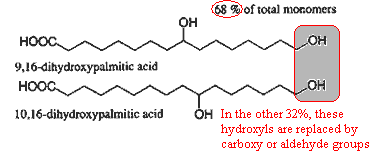 Cutin: the waxy substance of which a cuticle is composed. The basic structure of cutin is shown in the image.
Cutin: the waxy substance of which a cuticle is composed. The basic structure of cutin is shown in the image.
| Page Back | Page Top | Unit Home | Page Next |
checked ATW050802
modified ATW090313
Unless otherwise indicated, all text is public domain. No rights reserved.